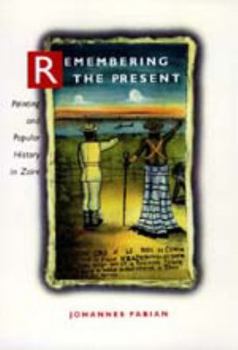Remembering the Present
Select Format
Select Condition 
Book Overview
This book combines ethnography with the study of art to present a fascinating new vision of African history. It contains the paintings of a single artist depicting Zaire's history, along with a series of ethnographic essays discussing local history, its complex relationship to forms of self-expression and self-understanding, and the aesthetics of contemporary urban African and Third World societies. As a collaboration between ethnographer and painter, this innovative study challenges text-oriented approaches to understanding history and argues instead for an event- and experience-oriented model, ultimately adding a fresh perspective to the discourse on the relationship between modernity and tradition.
During the 1970s, Johannes Fabian encouraged Tshibumba Kanda Matulu to paint the history of Zaire. The artist delivered the work in batches, together with an oral narrative. Fabian recorded these statements along with his own question-and-answer sessions with the painter. The first part of the book is the complete series of 100 paintings, with excerpts from the artist's narrative and the artist-anthropologist dialogues. Part Two consists of Fabian's essays about this and other popular painting in Zaire. The essays discuss such topics as performance, orality, history, colonization, and popular art.
During the 1970s, Johannes Fabian encouraged Tshibumba Kanda Matulu to paint the history of Zaire. The artist delivered the work in batches, together with an oral narrative. Fabian recorded these statements along with his own question-and-answer sessions with the painter. The first part of the book is the complete series of 100 paintings, with excerpts from the artist's narrative and the artist-anthropologist dialogues. Part Two consists of Fabian's essays about this and other popular painting in Zaire. The essays discuss such topics as performance, orality, history, colonization, and popular art.
Format:Paperback
Language:English
ISBN:0520203763
ISBN13:9780520203761
Release Date:December 1996
Publisher:University of California Press
Length:385 Pages
Weight:1.84 lbs.
Dimensions:1.0" x 7.0" x 10.0"
Customer Reviews
2 ratings
Manylayered views of Congo/Zaire history [4 1/2 stars]
Published by Thriftbooks.com User , 23 years ago
Anthropologist Johannes Fabian performed an outstanding service in sponsoring artist/historian Tshibumba's unique vision of his country's history. His words and the paintings themselves offer a rather romantic look at precolonial life, but a searing indictment of the epoch of Belgian rule. The interpretation of the Mobutu period is more equivocal, partly due to living under the authority of that regime, but also because Tshibumba genuinely admired some of Mobutu's achievements. Our artist vanished (presumably deceased) in the mid to late 1970s just as the tyrant's control began to go sour; it would be fascinating to read and see how Tshibumba assessed Mobutu's decline and fall. His history operates on three levels---through his startling folk images, his own words, and the dialogue which emerges out of interviews with Fabian. The result is probably the most fully realized popular interpretation of the history of any African country, though oriented toward Tshibumba's home province of Katanga (Shaba). Fabian's essays in Part II further enhance our understanding of their joint project, though a couple are dense enough to deter some students and lay readers, thus 4 1/2 stars. Overall, a stunning and memorable collaboration. If only we had more like it.... For another indigenous perspective on many of the same events, by a Katangese girl who grew to womanhood during the Mobutu era, see Suruba Wechsler, "By the Grace of God," less penetrating but rather more accessible. Useful background material is also available in works by Edouard Bustin, Thomas Kanza, Crawford Young, and David Birmingham & Phyllis Martin.
Manylayered views of Congo/Zaire's history [4 1/2 stars]
Published by Thriftbooks.com User , 23 years ago
Anthropologist Johannes Fabian performed an outstanding service in sponsoring painter/historian Tshibumba's unique vision of his country's history. His words and the paintings themselves offer a rather romantic look at precolonial life, but a searing indictment of the epoch of Belgian rule. The interpretation of the Mobutu period is more equivocal, partly due to living under the authority of that regime, but also because Tshibumba genuinely admired some of Mobutu's achievements. Our painter vanished (presumably deceased) in the mid to late 1970s just as the tyrant's control began to go sour; it would be fascinating to read and see how Tshibumba assessed Mobutu's decline and fall. His history operates on three levels---through his startling folk images, his own words, and the dialogue which emerges out of interviews with Fabian. The result is probably the most fully realized popular interpretation of the history of any African country, though oriented toward Tshibumba's home province of Katanga (Shaba). Fabian's essays in Part II further enhance our understanding of their joint project, though some are dense enough to deter some students and lay readers, thus 4 1/2 stars. Overall, a stunning and memorable collaboration. If only we had more like it.... For another indigenous perspective on many of the same events, by a Katangan girl who grew to womanhood during the Mobutu era, see Suruba Wechsler, "By the Grace of God," less penetrating but rather more accessible. Useful background material is also available in works by Eduard Bustin, Crawford Young, and Phyllis Martin and David Birmingham.





